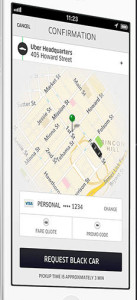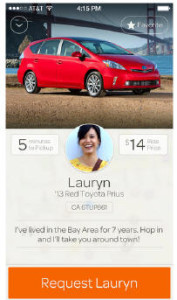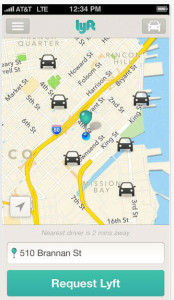by Larry Magid
This post is adapted from one that appeared in the San Jose Mercury News
The fact that the Internet has disrupted age-old businesses has become an old story. Just ask anyone in the record industry what happened to their profits now that there are legal and illegal ways for people to access just about any recording for free online. The Internet has also done a number on the newspaper industry and is starting to impact TV networks as well. It’s also put a lot travel agents out of business and — thanks to Airbnb, it’s even starting to have a small impact on the hotel business.

And, over the past couple of years, the Net and mobile technology is having an increasing impact on taxi and limousine services. Mobile phone apps like Uber and Lyft allow consumers to find a ride by using their fingers to touch their smartphone rather than lift their hand to hail a cab on the street or dial the company.
The apps take advantage of geolocation services (GPS and other technologies) to know where you are and where the drivers are. Based on proximity, the app tells you approximately how long it will take for the driver to reach you, and it handles calculating the fare and paying the bill and tip. You never have to shell out cash or swipe a credit card. That may not seem like a big deal, but having to take out your wallet, peel out bills and wonder if you’re getting the correct change can be a minor annoyance as you’re leaving a cab.
Also, because you’re using your cell phone and a registered debit or credit card, the driver knows who you are and vice versa, which makes it safer for both of you. And you have an electronic receipt, which would also make it easier to recover any items you might leave in the car.

A new player called Sidecar has just entered the field. The service, which currently operates in San Francisco, Los Angeles, Long Beach, San Diego, Seattle, Chicago, Boston, Austin, Texas, Philadelphia and Washington, D.C., allows drivers to set their own prices and pitch customers with such things as what kind of car they drive or how well they know the area. Clearly there are well-heeled investors who believe in this concept. The company just raised a $10 million round of capitol from Union Square Ventures.
Needless to say, services like these are not popular among traditional taxi services. In many cities, taxi companies pay a lot of money for their “medallion,” which amounts to a license to operate a single cab. According to The New York Times, a taxi company paid $2.5 million at auction last fall for two medallions. It will take a lot of fares to pay that back, and that doesn’t cover the cost of buying and operating the vehicles.
The industry has been taking its complaints to taxi commissions and other regulators in city after city. The Detroit Free Press quoted a representative of a local taxi company claiming that “Uber drivers skirt rules that require vehicle inspections and registration and also sometimes charge beyond regulated rates.” Others claimed that Uber and Lyft drivers have failed to get proper licenses to offer rides for hire.
Uber is being sued by the family of a 6-year old girl who died in San Francisco after being struck by an Uber driver on New Year’s Eve. The driver was operating his personal car and didn’t have a passenger on board at the time of the accident. But the suit alleges he was logged into the company’s UberX app, which means he was available to pick up a fare. If this had been a Yellow Cab, I don’t think there would be any question as to whether the company could be held responsible for the accident. Uber carries insurance to cover injuries to passengers, but the person killed wasn’t a passenger and it’s debatable whether the driver was working for Uber at the time of the accident or just someone driving his personal car who happened to be logged into the Uber app.

While it’s hard to imagine how a taxi company might benefit from services like these, drivers can because it gives them another work option. There are plenty of cases of taxi or limo drivers switching over to Uber or Lyft because of more flexible work hours and — potentially — better pay.
I’m generally a big fan of disruptive technology because it creates more options for consumers and forces the industry being disrupted to either innovate or evolve. But I make exceptions when government is involved, such as with taxation or licensing. For example, I love Amazon.com, but I didn’t think it was fair when Amazon didn’t have to charge sales tax while local merchants did. Now that Amazon is collecting sales tax in California and several other states, it’s a more even playing field.
And while I love the idea that innovative apps allow us to find nearby drivers and “hail a cab” with a few clicks, I don’t think it’s right that the legacy part of the industry has to put up with regulations, taxes and licensing fees that its newer and perhaps hipper and more tech-savvy competitors get to avoid.